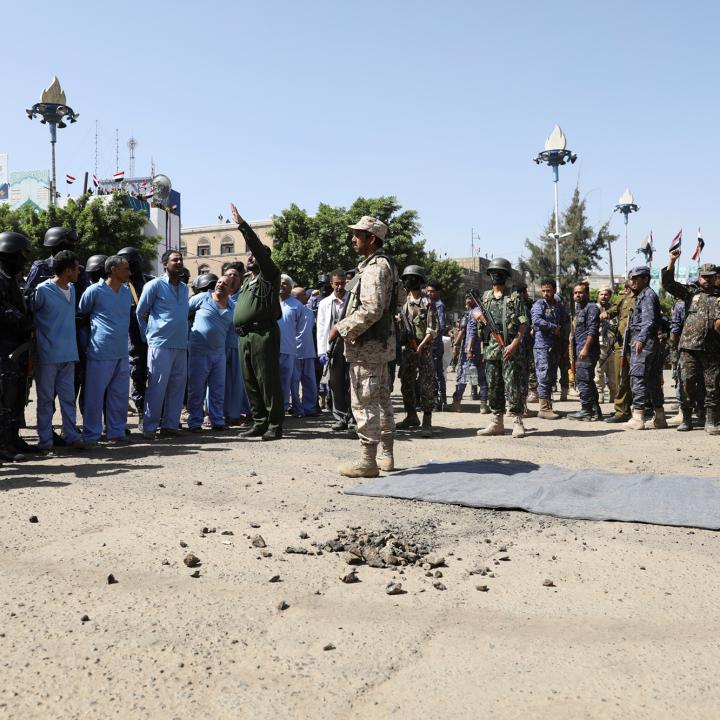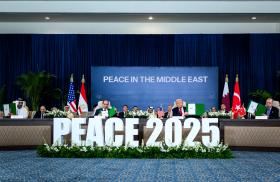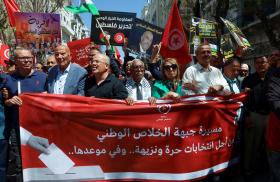
- Policy Analysis
- Fikra Forum
Yemen's Tihama People: A Forgotten Story Under Houthi Rule

Despite years of Houthi control, there remains local resistance forces who hope to take back the area from a group who occupied the Tihama region in order to control the strategic port of al-Hudayda and the area's other resources.
On May 6, the Trump administration abruptly announced that it had established a ceasefire with Houthi leadership in Yemen, under the agreement that Houthis cease targeting the vital red sea commercial pipeline. Yet the conflicts within Yemen remain—not least between the Houthis and the residents of al-Hudayda and its surrounding environs. Known as the region of Tihama, it and its capital Al-Hudaydah (aka Hodeidah) have already demonstrated that they are a critical factor in securing maritime navigation through the Red Sea, but the plight of Tihama residents stuck living under Houthi control have received far less international attention. Tihami residents remain trapped under the auspices of the unfulfilled Stockholm agreement, a 2018 agreement implemented under international pressure that left al-Hudayda under Houthi control.
Located on Yemen's western coast, Tihama stretches from the southern borders of Saudi Arabia in the north to the Bab al-Mandab Strait in the south—a strategic maritime passage connecting the Red Sea to the Indian Ocean. Furthermore, it hosts Yemen's most significant land border crossing with Saudi Arabia (Al-Tuwal) and key Red Sea ports (Al-Hudaydah, Salif, Ras Isa, Midi, and Mocha), generating hundreds of billions of riyals yearly. This unique geographical position makes it a pivotal point for global trade and regional stability, with a significant portion of international maritime shipments passing through it.
Tihama is home to 6 to 7 million people descending from tribes with deep historical roots stretching back over two thousand years (e.g., Akk, Asha'ira, and Hakam), and who share a cohesive social, cultural, and intellectual fabric. Tihama's diverse resources—ports, fisheries, agriculture, and livestock—have long sustained Yemen's domestic market and exports. Notably, the port of Mocha, along with others like Midi, was central to the Arabian coffee trade, making coffee a major source of regional wealth.
This importance has made Tihama a target for numerous great powers throughout history, such as the Ottomans, Portuguese, Italians, and British, who sought to control Tihama and its ports to bolster their naval and commercial power in the Red Sea. In the modern era, the region’s value has only intensified; the Red Sea corridor remains one of the world’s most critical maritime arteries, facilitating between 12% to 15% of global trade and up to 30% of container shipping annually in 2023. By 2050, the Red Sea region's GDP is projected to grow from $1.8 trillion to $6.1 trillion—more than tripling—while trade volume expands from $881 billion to $4.7 trillion, a fivefold increase driven by the energy and oil sectors. However, Tihama has also endured decades of exclusion and marginalization—the perception in Tihama is often that successive ruling authorities treat the region as spoils of war and a tax collection zone, rather than supporting the human capital or infrastructure of the region. Tihami Yemenis specifically pointed to military and security academies, including the Naval Academy in Hodeidah, understood as largely reserved for members of the Zaidi sect and without equitable distribution criteria.
Most recently, Tihama's geographic wealth has made it a primary target of the Iran-backed Houthi militia. Since their early takeover of Al-Hudaydah during the conflict, the Houthis have utilized the port to receive a variety of smuggled weapons through an extensive network supervised by Iran's Revolutionary Guard Corps, and more recently by paralyzing maritime traffic through the Red Sea (with exceptions for Russian and Chinese vessels), costing Western economies billions of dollars in losses and a precipitous decline in Suez Canal revenues.
However, the Houthis should not be confused with the local population of Tihama. During the Houthi militia's initial invasion of Tihama and Al-Hudaydah in late 2014, widespread protests emerged rejecting this occupation. Their motivation stemmed from adherence to the National Dialogue outcomes—overturned by the Houthis and Yemen’s former dictator Ali Abdullah Saleh—which, if implemented, would have granted Tihama fairer participation in power and wealth through a federal regional system. Equally significant was religious tension—Tihama's people, who follow the moderate Shafi'i school, refused to accept the Houthi militia's efforts at political control and their own specific understanding of Zaydi religious doctrine.
When the militia responded with violence and armed suppression, it prompted local residents to take up arms and form a popular resistance to defend their land. The Tihama resistance persisted until late 2018, when, in collaboration with southern forces and the Republican Guard, and with support from the UAE military within the Arab Coalition, they advanced to within a stone's throw of Al-Hudaydah's port. They had liberated large parts of the city and imposed a siege on the remaining Houthi elements. These forces were on the verge of recapturing the city when international pressure—primarily from the United States and the United Kingdom—intervened to impose the Stockholm Agreement. Theoretically, this agreement stipulates the withdrawal of the Houthi militia from the city and port of Al-Hudaydah as well as other Tihama ports.
Yet brokered under the United Nations' auspices, this agreement halted the military advance and gave the Houthis an opportunity to reinforce their grip on the region, prolonging the crisis without a radical solution. And when the Houthis refused to abide by the parameters of the Stockholm agreement—and without the Quartet developing a mechanism to credibly enforce it—the militia felt able to escalate the pace of supply and smuggling operations facilitated by Houthi control over Al-Hudaydah and the Tihama coast, increasing militia access to advanced weaponry that allows the militia to now shoot down MQ-9 drones and even attempt to down an F-16 aircraft over the Red Sea.
Paradoxically, while the Stockholm Agreement was imposed for "humanitarian reasons," its lack of a clear pressure mechanism against the Houthis has allowed for the continued subjugation of western Yemen's Tihama natives. Houthi control of the Red Sea waterways comes at the expense of Tihama's native population—who historically used the waters for fishing, not the type of piracy displayed by the Houthis—as well as national, regional and international security. The militia has exacerbated their suffering by plundering Tihama's port revenues, imposing various taxes and levies, and profiteering from services like electricity, in blatant violation of the Stockholm Agreement's terms.
Houthis have also killed Tihami natives in retaliation for international strikes on Houthi leadership. In August 2020, the Houthi militia issued a death sentence against President Trump and 61 other defendants, including 10 Tihama natives, when the Houthis claimed that they were responsible for the killing of Houthi leader Saleh al-Sammad—head of the group's political council—who was killed in an airstrike in Tihama's Al-Hudaydah on April 19, 2018, prior to legitimate government forces, including the Tihama resistance, surrounding the city and port of Al-Hudaydah from three directions after liberating the strategic coastal strip of Tihama along the Red Sea from Bab al-Mandab to Al-Hudaydah.
On September 18, 2021, the Houthis carried out an execution of nine Tihama natives in Sanaa (pictured above), including a minor (with a tenth killed under torture in Houthi prisons earlier), after falsely accusing them of involvement in the killing of Houthi leader Saleh al-Sammad, head of their political council, who died in a coalition airstrike. Abdul Majeed Sabra, the victims' lawyer, states that coerced confessions were extracted under brutal torture—one of whom died in prison as a result. While the killings were broadly condemned abroad, these condemnations did not translate into action against the Houthi militia, again establishing a pattern where Houthis failed to face consequences for their actions against the local population.
In May 2024, the Houthis abducted 11 Tihama residents, falsely accusing them of spying for the U.S. and Israel, while abducting over 60 others in Sana'a under the same charges. These individuals faced severe torture and public humiliation, including being paraded in public spaces and having their images defiled. According to available information and investigation records, some abductees denied all charges before the Houthi-controlled prosecution, stating that video-recorded confessions were extracted under extreme torture. More recently, on December 17, 2024, the Houthis abducted a 45-year-old Tihama woman from her displacement camp in Al-Durayhmi district south of Al-Hudaydah; on December 28, citizens found her body dumped in a desert area of the city, bearing torture marks.
Outside of direct acts against Tihama Yemenis, Houthi mines claim numerous civilian lives in Tihama, primarily children and women. The pattern of sectarian violence, abductions, torture, and forced displacement by the Houthi group against Tihama's residents is a clear violation of international human rights standards. This includes recent atrocities in Bani Abaqa, Al-Durayhmi, Al-Qasra, Daqawna in Bajil district east of Al-Hudaydah, and the villages of Manzar and southern Al-Jarahi.
Today, the Houthi militia remains in control of this key seaport, providing them with leverage to restart their attacks against shipping networks at any time. Meanwhile, the Tihama resistance also remains, and now includes seven purely Tihami brigades stationed south of Al Hudaydah alongside southern forces and the Republican Guard, whose brigades are also largely composed of Tihami officers and soldiers. In order to develop a more sustainable end to the Houthi’s oversized power and leverage, external military solutions will continue to prove insufficient; the ongoing threat to global trade security and Yemen's stability demands a comprehensive and sustainable domestic strategy against the Houthis.
If there is international interest in securing the Red Sea in the long term, local Tihama resistance and its partners are ready, with the necessary support, to fight to liberate Al-Hudaydah—and the entire region—from Houthi control. Removing Houthi territorial control of Al-Hudaydah, Salif, and Ras Isa will deprive the militia of substantial funding sources for its war efforts while returning its governance to the local population. Additionally, the role of Tihama's people in Yemen's coast guard can be strengthened to ensure effective local control over territorial waters. As the Arab proverb says, "The people of Mecca know its pathways best": the local population is best equipped to safeguard their land and interests with precise knowledge of its terrain and needs.


